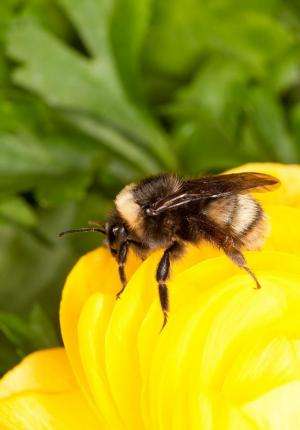Rare western bumblebee creates a buzz

When University of Colorado Boulder junior Cole Steinmetz first begins a bumblebee hunt, he walks slowly, listening for the bee's persistent, rumbling buzz, which Steinmetz has learned is usually lower and less singsongy than the noises made by flies and other insects.
When he's zeroed in on the buzz and found his fuzzy target he readies his net, which he drops gently on the bumblebees he finds nose-deep in blooming purple bee balm, loco weed, musk thistle or other wildflowers.
Steinmetz and his fellow bee hunters, four other student researchers under the direction of CU-Boulder biologists Carol Kearns and Diana Oliveras, have spent their summer netting bumblebees near Boulder and in the mountains above campus. Their efforts have paid off.
They've captured and identified hundreds of bumblebees and found, among them, more than a dozen Bombus occidentalis, the rare western bumblebee. Since the late 1990s, the western bumblebee, identified by its characteristic white rump, has been in steep decline in its native range, which stretches across the western United States and Canada.
While reports of a few western bumblebee sightings on Colorado's Western Slope have flown around the bee community, the bees have been noticeably absent along the Front Range.
The first western bumblebee was captured by last year's undergraduate bumblebee researchers. But Oliveras and Kearns, both of whom teach in CU-Boulder's Baker Residential Academic Program, wanted to wait to see if the bumblebees could be found two years in a row before announcing that B. occidentalis might be making a Colorado comeback.
"Last year, one of our students caught one and he said, 'This is occidentalis! This is occidentalis!" Kearns said.
"We pooh-poohed him," Oliveras said. "But sure enough, it was a western bumblebee. We actually found them in two plots last year, and this year we've been getting them in multiple plots."
In all, the survey team has found more than 20 western bumblebees over two summers, and the bees were found at multiple locations between 5,000 and 10,000 feet, suggesting that there are several colonies in the area.
The discovery that western bumblebees have indeed returned to the Front Range was really just a bonus for the bumblebee researchers. The real purpose of the five-year CU-Boulder bumblebee survey, which will wrap up next summer, is to better understand the diversity of bumblebees in the area and their population numbers. Each summer, undergraduates, nets in hand and vials in pocket, have been employed to hunt for the pollinators.
This summer's undergraduates, all of whom participated in one of CU-Boulder's residential academic programs, said the experience of surveying bumblebees has taught them a lot, from a broader understanding of what it's like to do real research to the finer techniques of catching and identifying bumblebees. (For example, shooing the netted bee into a vial and then cooling it down in an insulated lunchbox containing an ice pack slows the bee down, allowing for the insect to be accurately identified before being rewarmed and safely released back to its meadow.)
Sarah Niemeyer, a junior majoring in integrative physiology, was driven to get involved with the bumblebee survey by a general concern about the decline of pollinators. But during the course of the summer, her education has expanded beyond the insects.
"I'm not just learning about bees," she said. "I'm learning about the whole ecosystem they're surrounded by." Niemeyer said hours spent slowly walking across research plots in search of insects has also taught her to appreciate the details in nature, and she finds herself noticing the little things—like tiny blooms on the side of the trail— when she's out hiking for fun.
The student researchers—who include Benjamin Bruffey, Sam Canter and Zoe Praggastis, along with Niemeyer and Steinmetz—also agreed that the field locations for the bee survey, which include some high-alpine locations in the Indian Peaks wilderness near the Continental Divide, were one of the best parts of the project.
"CU has a really great biology program," said Praggastis, a sophomore majoring in molecular, cellular and developmental biology. "There are a lot of really great opportunities to go out and do research in one of the most beautiful places in the world. I think just about anybody would enjoy fieldwork here."
Provided by University of Colorado at Boulder

















